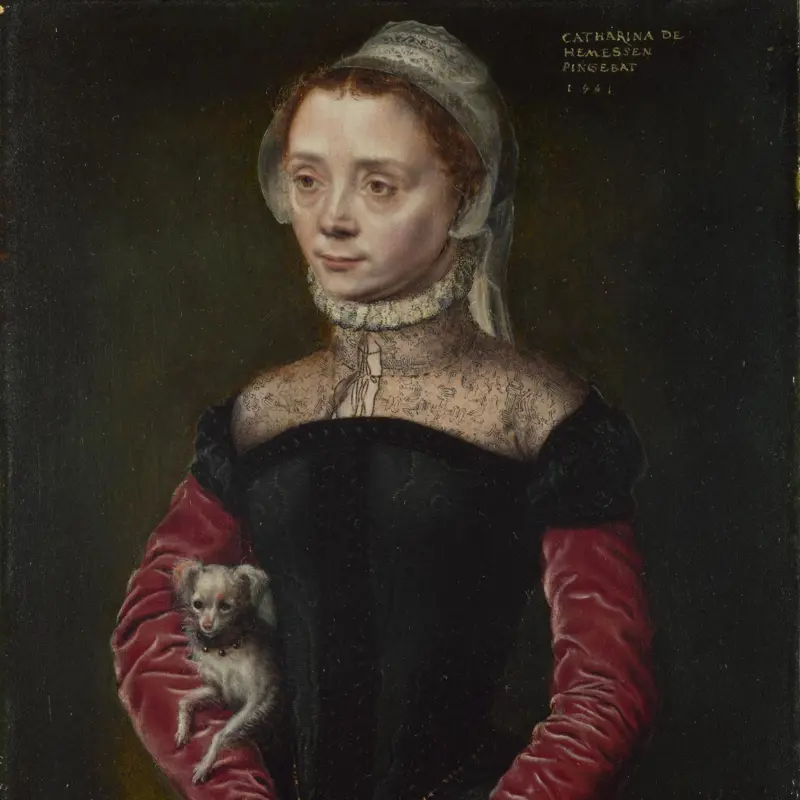Catharina van Hemessen, 'Portrait of a Man', possibly 1552
About the work
Overview
The Latin inscription in the top right corner names the painter: CATHARINA. FILIA /IOHANNIS DE HEMES/SEN PINGEBAT. 1552. (‘Catharina, daughter of Johannes de Hemessen was painting [this]. 1552.’). Catharina van Hemessen is the first woman artist from Flanders for whom we have a confirmed body of work.
We do not know the sitter’s identity, but he was clearly a wealthy man probably of noble birth, as the privilege of wearing a sword indicates. His belt has gold ornaments, and the pommel of his sword too is golden. He wears gold rings on his fingers – one set with a shield, quartered in red and blue – and another hangs from a chain around his neck. In the mid-sixteenth century it was relatively common for people to wear rings on necklaces, possibly as pledges of affection.
The pose – one hand on the hip and the other grasping the hilt of a sword – emulates portraits painted at the Habsburg courts in the 1540s. Catharina effectively channelled the monumentality and formality of such portraiture on a small scale.
Key facts
Details
- Full title
- Portrait of a Man
- Artist
- Catharina van Hemessen
- Artist dates
- 1527/8 - after 1566?
- Date made
- Possibly 1552
- Medium and support
- Oil on wood (probably oak)
- Dimensions
- 36.2 × 29.2 cm
- Inscription summary
- Signed; Dated
- Acquisition credit
- Bought, 1878
- Inventory number
- NG1042
- Location
- Not on display
- Collection
- Main Collection
Provenance
A portrait of a man by Catharina van Hemessen was included in the inventory, taken at Antwerp in October 1642, of the estate of the picture dealer Herman I de Neyt: ‘Een Manstronie van Catri Hemssen, geteekent ... Nᵒ 567’. The London portrait was by 12 May 1875 in the possession of James C. Wallace. On that date, writing from 23 Pakeman Street, Holloway (London N7), he offered it for sale to the National Portrait Gallery; but his offer was declined. On 1 June 1878, the same James C. Wallace, writing from the same address, offered the portrait for £60 to the National Gallery. Meeting on 1 July 1878, the Trustees decided to acquire the picture, which was bought out of the Lewis Fund. Wallace’s receipt for £60 and his covering letter to Burton, dated 25 November 1878, were sent from 23 Pakeman Street.
Additional information
Text extracted from the ‘Provenance’ section of the catalogue entry in Lorne Campbell, ‘National Gallery Catalogues: The Sixteenth Century Netherlandish Paintings: With French Paintings before 1600’, London 2014; for further information, see the full catalogue entry.
Exhibition history
-
2021The Director's Choice: Lizards, Fancy Feathered Hats and TrickeryThe National Gallery (London)5 May 2021 - 9999
Bibliography
-
1945Davies, Martin, National Gallery Catalogues: Early Netherlandish School, London 1945
-
1955Davies, Martin, National Gallery Catalogues: Early Netherlandish School, 2nd edn (revised), London 1955
-
1987Davies, Martin, National Gallery Catalogues: The Early Netherlandish School, 3rd edn, London 1987
-
2001
C. Baker and T. Henry, The National Gallery: Complete Illustrated Catalogue, London 2001
-
2004M. Droz-Emmert, Catharina van Hemessen: Malerin der Renaissance, Basel 2004
-
2014
L. Campbell, National Gallery Catalogues: The Sixteenth Century Netherlandish Paintings: With French Paintings before 1600, 2 vols, London 2014
About this record
If you know more about this work or have spotted an error, please contact us. Please note that exhibition histories are listed from 2009 onwards. Bibliographies may not be complete; more comprehensive information is available in the National Gallery Library.

